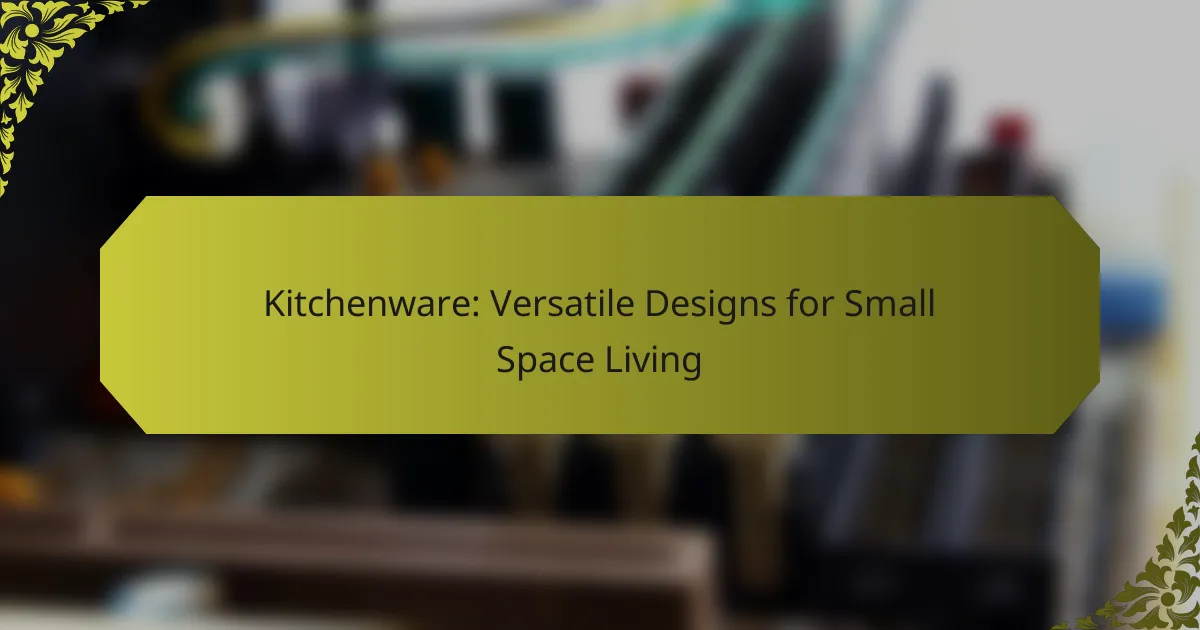Color plays a crucial role in the kitchen, influencing mood, appetite, and even the perceived taste of food. The selection of kitchenware colors can create an inviting atmosphere that enhances the cooking experience, while thoughtful design improves usability and efficiency, making culinary tasks more enjoyable and streamlined.

How does color influence cooking in kitchenware?
Color significantly impacts cooking by affecting mood, appetite, and even perceived taste. The hues of kitchenware can create an environment that either stimulates or calms, influencing the overall cooking experience.
Warm colors enhance appetite
Warm colors like red, orange, and yellow are known to stimulate appetite and create an inviting atmosphere. These colors can make food appear more appealing and vibrant, encouraging people to eat more. For example, using red utensils or plates can enhance the visual appeal of dishes, making meals feel more satisfying.
Incorporating warm colors into kitchenware can be as simple as choosing brightly colored pots or tableware. Consider using these colors for serving dishes or accent pieces to create a lively dining experience.
Cool colors promote calmness
Cool colors such as blue, green, and purple tend to evoke feelings of tranquility and relaxation. These shades can create a soothing environment, making cooking feel less stressful and more enjoyable. For instance, a blue kitchen can help reduce anxiety during meal preparation.
When selecting kitchenware, consider using cool-toned items for storage containers or dishware. This can help create a balanced atmosphere that encourages a peaceful cooking process.
Color psychology in kitchen design
Color psychology plays a crucial role in kitchen design, influencing both functionality and aesthetics. The right color scheme can enhance creativity and productivity while cooking. For example, a balanced mix of warm and cool colors can cater to both appetite stimulation and relaxation.
When designing your kitchen, think about how different colors will interact. Use warm colors for areas where food is prepared and cool colors in dining spaces to create a harmonious flow. This approach can lead to a more enjoyable cooking and dining experience.

What are the best color choices for kitchenware?
The best color choices for kitchenware can significantly influence your cooking experience and the overall ambiance of your kitchen. Colors like red, blue, and green each evoke different emotions and can enhance your culinary activities in unique ways.
Red for energy and excitement
Red kitchenware is associated with energy and excitement, making it an excellent choice for those who enjoy vibrant cooking environments. This color can stimulate appetite and encourage lively interactions during meal preparation.
When selecting red kitchenware, consider items like cookware, utensils, or even small appliances. Opt for shades that complement your kitchen’s overall design, ensuring that the vibrant hue enhances rather than overwhelms the space.
Blue for tranquility and focus
Blue kitchenware promotes tranquility and focus, making it ideal for those who prefer a calm cooking atmosphere. This color is known to reduce stress and create a serene environment, which can be beneficial during complex cooking tasks.
Incorporate blue kitchenware through dishware, storage containers, or decorative elements. Lighter shades can create a more spacious feel, while darker tones add sophistication. Aim for a balance that maintains a peaceful vibe in your kitchen.
Green for freshness and health
Green kitchenware symbolizes freshness and health, making it a popular choice for those who prioritize nutritious cooking. This color is often linked to nature and can inspire healthier eating habits.
Choose green kitchenware such as cutting boards, bowls, or kitchen textiles to enhance the fresh feel of your cooking space. Consider varying shades of green to reflect the season or your personal style, ensuring that the color scheme remains cohesive and inviting.

How does design affect cooking efficiency?
Design significantly impacts cooking efficiency by enhancing usability and streamlining tasks. Thoughtful kitchenware design can reduce preparation time, improve comfort, and facilitate organization, all of which contribute to a smoother cooking experience.
Ergonomic designs improve comfort
Ergonomic kitchenware is crafted to fit the natural contours of the hand and body, reducing strain during use. For instance, knives with comfortable grips and pots with well-placed handles can minimize fatigue, allowing for longer cooking sessions without discomfort.
When selecting kitchen tools, look for features like soft-touch grips, balanced weight, and easy-to-reach controls. These elements can make a significant difference in how efficiently you cook, especially during lengthy meal preparations.
Multi-functional tools save time
Multi-functional kitchen tools combine several functions into one device, which can drastically cut down on preparation time. For example, a food processor can chop, slice, and puree, eliminating the need for multiple gadgets and reducing cleanup time.
Investing in versatile tools can streamline your cooking process. Consider items like a blender that also functions as a food processor or a pot that can be used on the stovetop and in the oven. This not only saves time but also conserves space in your kitchen.
Space-saving designs enhance organization
Space-saving kitchenware is designed to maximize storage and minimize clutter, which can lead to a more efficient cooking environment. Stackable containers, nesting bowls, and collapsible utensils help keep your kitchen organized and accessible.
To improve your kitchen’s functionality, opt for tools that can be easily stored away when not in use. This allows for a more organized workspace, making it easier to find and access the items you need while cooking, thus enhancing overall efficiency.

What are the top kitchenware brands influencing design?
Several kitchenware brands significantly influence design through their innovative use of color, materials, and functionality. Brands like Le Creuset, KitchenAid, and OXO are renowned for their unique contributions that enhance both aesthetics and cooking efficiency.
Le Creuset for color and durability
Le Creuset is famous for its vibrant enameled cast iron cookware, which combines aesthetic appeal with exceptional durability. The brand offers a wide range of colors, allowing cooks to express their personal style while enjoying products that can withstand high temperatures and resist chipping.
When choosing Le Creuset, consider the size and shape of the cookware that best fits your cooking needs. Their Dutch ovens are particularly popular for slow cooking and baking, making them a versatile addition to any kitchen.
KitchenAid for design and functionality
KitchenAid is synonymous with high-quality kitchen appliances, particularly its iconic stand mixers. The brand emphasizes both design and functionality, offering a variety of colors and attachments that cater to different culinary tasks.
When selecting KitchenAid products, look for models that include multiple speed settings and attachments for versatility. Their mixers can handle everything from whipping cream to kneading dough, making them a staple for both amateur and professional chefs.
OXO for ergonomic innovations
OXO focuses on creating kitchen tools that prioritize user comfort and efficiency. Their ergonomic designs often feature soft grips and intuitive shapes, making cooking easier and more enjoyable.
When considering OXO products, pay attention to their measuring cups and peelers, which are designed to reduce strain during use. This attention to ergonomics can significantly enhance the cooking experience, especially for those who spend extended periods in the kitchen.

What criteria should you consider when selecting kitchenware?
When selecting kitchenware, consider factors such as material quality, color compatibility with your kitchen decor, and functionality. These criteria will help ensure that your kitchenware not only looks good but also performs well and lasts over time.
Material quality and durability
Material quality is crucial for kitchenware, as it directly impacts durability and performance. Common materials include stainless steel, cast iron, and non-stick coatings, each offering different benefits. For instance, stainless steel is resistant to rust and corrosion, while cast iron provides excellent heat retention.
When choosing kitchenware, look for products that are labeled as dishwasher-safe or oven-safe, as these features enhance convenience. Additionally, consider the warranty offered by manufacturers, which can be a good indicator of the product’s expected lifespan.
Color compatibility with kitchen decor
Color compatibility can significantly influence the overall aesthetic of your kitchen. Choose kitchenware that complements your existing decor, whether it’s a modern, rustic, or traditional style. Neutral colors like white or gray can blend seamlessly, while bold colors can add a pop of personality.
Consider the color scheme of your cabinets, countertops, and walls when selecting kitchenware. For example, if your kitchen features warm tones, earthy colors like terracotta or olive green may work well. Additionally, think about how the colors of your kitchenware will look when displayed on shelves or countertops.
Functionality and ease of use
Functionality is key when selecting kitchenware, as it should meet your cooking needs efficiently. Look for items that are designed for specific tasks, such as measuring cups for accuracy or versatile pans that can be used for various cooking methods. Ergonomic designs can also enhance ease of use.
To ensure ease of use, consider the weight and handle design of your kitchenware. Lightweight materials are easier to maneuver, while comfortable grips can prevent accidents. Always read reviews to gauge how well a product performs in real-world cooking scenarios before making a purchase.

How can you maximize the impact of kitchenware color?
To maximize the impact of kitchenware color, choose hues that complement your kitchen’s overall design while enhancing your cooking experience. Consider how different colors can influence mood and appetite, and select items that create a cohesive look.
Use color accents for visual appeal
Incorporating color accents can significantly enhance the visual appeal of your kitchen. Use vibrant utensils, dishware, or small appliances to create focal points that draw attention and add personality to the space.
Consider pairing neutral-colored cabinets and countertops with bold-colored kitchenware. For example, a bright red kettle or a set of turquoise mixing bowls can stand out against a white backdrop, making the kitchen feel lively and inviting.
When selecting color accents, think about the overall theme of your kitchen. If you have a rustic design, earthy tones like olive green or terracotta can complement the aesthetic. In contrast, a modern kitchen may benefit from sleek, bright colors like lime green or electric blue.


